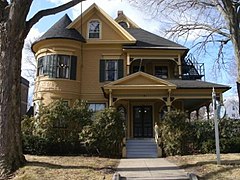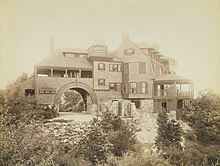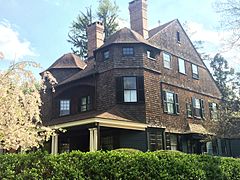Queen Anne style architecture in the United States
The popularity of high Queen Anne style waned in the early 1900s, but some elements continued to be found on buildings into the 1920s, such as the wrap-around front porch (often L-shaped).
Gabled and domestically scaled, these early American Queen Anne homes were built of warm, soft brick enclosing square terracotta panels, with an arched side passage leading to an inner court and back house.
In the Shingle style, English influence was combined with the renewed interest in Colonial American architecture which followed the 1876 celebration of the United States Centennial.
Some architects, in order to attain a weathered look on a new building, even had the cedar shakes dipped in buttermilk, dried, and then installed, to leave a grayish tinge to the façade.
[citation needed] McKim, Mead and White and Peabody and Stearns were two of the notable firms of the era that helped to popularize the shingle style, through their large-scale commissions for "seaside cottages" of the rich and the well-to-do in such places as Newport, Rhode Island.
However, the most famous Shingle-style house built in America was "Kragsyde" (1882), the summer home commissioned by Bostonian G. Nixon Black, from Peabody and Stearns.








